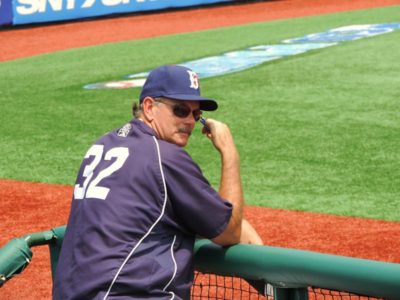
Photo credit: Pat Sanchez
While pitching coaches at various levels of a club may have different views on the art, the organizational philosophy must remain the same throughout. The man tasked with implementing and overseeing those philosophies with the Mets is Ron Romanick, the minor league pitching coordinator.
Romanick joined the Mets in 2012, after spending the previous 13 seasons with the Oakland Athletics. He was their minor league pitching coordinator from 1999-2007, the major league bullpen coach from 2008-2010, and the major league pitching coach in 2011, under former Mets bench coach Bob Geren. Prior to his time in the Athletics organization, Romanick was the roving pitching instructor for the Seattle Mariners.
The Arizona State product was selected fourth overall in the 1981 January draft by the California Angels, spending three years in the minor leagues before making his major league debut on April 5, 1984. Romanick would go on to make 82 major league starts from 1984-1986, compiling a 31-29 record with a 4.24 ERA. He joined the Yankees organization in 1987 and played his final season in 1988 with the Milwaukee Brewers’ Triple-A team in Denver.
Mets Minors caught up with Romanick while he was visiting the Brooklyn Cyclones on August 12, 2016.
How has your stay in Brooklyn been so far?
Not bad. I started with them in Tri-City, picked them up in Albany, and I’m going to follow them through the homestand here.
When you visit a team in the organization, do you come in with a specific message, or do you assess what you have first and go from there?
Well this is the third time I’ve been in and I try to hit each club three times. This is a short season club so they started late, and I’ll try to get in one more time. The first time you go in, it’s about introducing them to our throwing program and the organization’s philosophy, and basically to come and see if they’re healthy and where we’re going to pitch them at in the rotation. We have more than 13 here, so we can take a little time and not push anybody.
We hear a lot about the ten-day throwing program with first year guys. Could you describe what that is and what it involves?
I assume that most of the college kids are tired, they’ve been used a lot, so the most important thing is to get them back on a schedule. A ten-day progression is like an insurance policy. I know most college programs don’t give enough time for flat-ground throwing before they go to the mound. So this ten-day progression is a three-day cycle, and it’s a minimum ten days of two days flat ground throwing and one day mound work. And after that tenth day, they should be able to go an inning. It takes a little bit longer, but you get more guys that are healthy. We do it in spring training, and for whatever reason, just because I’ve tried the other ways, that three-day cycle seems to be perfect. It’s a pre-hab program.
This team is not lacking in the pitching department, and one of the bigger names is Justin Dunn. What were your first impressions of him?
I actually saw him pitch before I met him, and he’s very athletic. I saw film on him before and after we drafted him, and he’s just a very nice young man. Wants to listen, wants to learn, but I just see athleticism, great natural gifts. He embraced the organizational philosophy, and basically we’re going to let him pitch and teach him how to prepare to pitch. The first year guys, they pitched a lot in college, so it’s not about the workload here, it’s about getting them used to what the professional game is all about.
How does the organization go about developing a guy like Dunn, who projects as a starter but isn’t throwing starter innings here?
We do a lot of six man rotations and piggybacks here. He prepares just like a starter, whether he starts the game or comes in behind somebody, it’s really the same thing. A couple times out he’s going to get three innings, and we want to see him develop the changeup. That is a core philosophy here since I was hired over here five years ago, to introduce the fastball command and work the changeup in. That’s the thing I really want to see. I know they’re tired, it’s the end of the year, they should feel like they could do more when they leave here, and we have enough pitchers to do that.
Thomas Szapucki has really blown the competition out of the water at both Kingsport and Brooklyn. How has he developed from the time he was drafted to now?
He’s a young, 18-year-old kid, they’re different. It’s like raising kids, you have to treat them differently. He’s embraced the changeup here. You need it or use it a lot in Kingsport, but again, the first or second year here, and that’s part of my job, is to make sure we’re doing the right things at the right levels. He’s overachieving, his stuff is phenomenal, and he’s picked up the changeup here.
It’s the first full season with him, so we’re trying to stretch him out and build the innings with him to where, if he gets the chance to go to New York one day, he’ll have the necessary tools, and be able to go 200 innings his first year in the big leagues.
When you’re developing that changeup with Szapucki and others, is it as simple as showing him the grip and having him repeat it in the bullpen over and over, or is there a specific drill you guys work on?
Everybody is different. It’s a core thing we do in our daily throwing program, we crow hop them at 80 feet. We don’t learn a changeup from the mound, I’ve learned that from 30 something years doing this, you learn it in the flat ground throwing, and everybody is different. If you’re a two-seam guy, a four-seam guy, there’s a bunch of different ways to do it, but once you find that grip, and once you get enough reps in, you can take it out in the games. So basically that’s what he did with him. We made a few suggestions, and once he throws a couple, he’ll know after a couple he throws from 80 feet it has that action to it, the backup action and the drop action. He’s got both. He likes it and it comes natural, but you’ve got to marry it with the fastball. If you don’t do that, you won’t have success with it and you’ll never stay with it.
Harol Gonzalez has had a real breakout season, but his fastball velocity has been in the high 80s. Is that something that worries you, or do you think the velocity will come?
He’s getting a little breaking-ball happy here. He’s got good breaking stuff and a good fastball, so after he pitches in the all-star game, we’re going to redo his mix a little bit, get him to get his fastball percentages up, and I think the velocity will come with that. We check the mix, we have a nice thing called TrackMan, so there’s no conjecture anymore. It’s pretty accurate, and you can take that information right to him and say, “Hey, you’re doing really good, but we’re here to develop major league players, not minor league all-stars.” It’s nice to do both, but if we had our druthers we’d like to see him pitching down the street a little way. So that’s the goal.
The bullpen has a lot of interesting names. Joseph Zanghi is throwing 95 miles per hour, Austin McGeorge was drafted this year. Who has stood out for you?
They’re all different. We’ve got a lot of arms here, and everybody has a role currently. Zanghi, a converted guy, J.P. Ricciardi brought him in late in spring training, he’s a converted catcher, so he’s done a nice job. The new kids we’ve added, they’re on restricted innings, giving them the maximum amount of rest. [Alejandro] Castro last night kinda went back to his old style. It’s not the amount that these guys pitch, it’s learning to prepare to go out and pitch. We’re not here to overly tax somebody at this level, but we want them to learn the routines and learn to prepare every day.
When guys like Seth Lugo, Erik Goeddel, and Hansel Robles move up to the big league club, and you see them on TV, pitching in front of big crowds, is that a source of pride for you, knowing that you helped them get there?
Well it’s us and we. Starting with Oakland, we had three waves of guys coming out of the system. I had a chance to be a major league coach there on the other side, as well as a coordinator. The guys when I started here five years ago, there was a lot of talent here, and it’s all getting them healthy. The pitching coaches that I hire always say that it’s our program, we do it, so when they go up to the big leagues, it’s more about what player development did, and people don’t realize that there’s a lot of guys that put their hands on all these guys.
For instance, Rob Whalen did a nice thing the day before he got his call-up, he called every coach over here, including myself, and thanked them. It was one of the classier things that anyone had ever done. Once in a while, nice things like that will happen, but he called every pitching coach that helped him along the way, and that becomes a good moment.
So where are you headed next?
I am going to go home, because I’ve been on the road for three weeks, and then I’m going to turn and hit every club once before the end of the season.


Nice job Jacob! Interesting stuff.
Very nice interview. Very informative. This is the kind of info I appreciate – behind the scenes, rather than regurgitation of the standard or what’s already known.
Thanks for reading! He was a great guy to talk to, very experienced and verbose. Doesn’t hurt to have a wealth of those guys in the organization.
Thank you!
Nice read, good job kid. Who is the next Lugo/Bradford?
<<hp. ★★✫★★✫★★✫★★✫★★✫★★✫★★✫★★✫★★✫★★✫★★✫★★✫★★✫★★✫★★✫★★✫★★✫★★::::::!i428m:….,…..
Jacob, great job. Quite a catch!